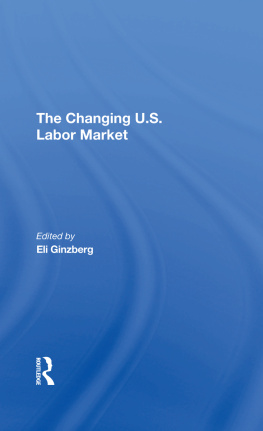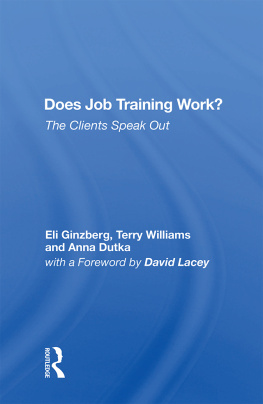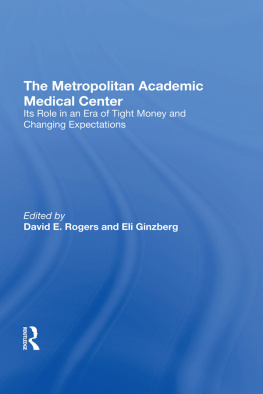MY
BROTHERS
KEEPER
MY
BROTHERS
KEEPER
ELI GINZBERG
First published 1989 by Transaction Publishers
Published 2017 by Routledge
2 Park Square, Milton Park, Abingdon, Oxon OX14 4RN
711 Third Avenue, New York, NY 10017, USA
Routledge is an imprint of the Taylor & Francis Group, an informa business
Copyright 1989 by Taylor & Francis.
All rights reserved. No part of this book may be reprinted or reproduced or utilised in any form or by any electronic, mechanical, or other means, now known or hereafter invented, including photocopying and recording, or in any information storage or retrieval system, without permission in writing from the publishers.
Notice:
Product or corporate names may be trademarks or registered trademarks, and are used only for identification and explanation without intent to infringe.
Library of Congress Catalog Number: 88-36523
Library of Congress Cataloging-in-Publication
Ginzberg, Eli, 1911-
My brothers keeper / Eli Ginzberg.
p.cm
Bibliography: p.
Includes index.
ISBN 0-88738-291-6
1. Ginzberg, Eli, 1911-. 2. Jews - United States - Bibliography. 3. Economists - United States - Biography. I. Title.
E184.J5G466 1989
973 .04924024 - dc19
[B]
88-36523
CIP
ISBN 13 : 978-1-4128-0862-0 (pbk)
To the memory of
Frank I. Schechter
and in celebration of
four generations of friendship between the Schechter
and the Ginzberg families
Contents
After I had completed a draft of the manuscript I benefited from the advice of my daughter, Abigail, and four friends who read it: Professor Moses Abramovitz of Stanford University; Professor Irving Louis Horowitz, President of Transaction Publishers, Rutgers University; Mrs. Miriam Ostow, Conservation of Human Resources, Columbia University; and Professor Yosef Hayim Yerushalmi of Columbia University. The advice that I received from them helped me to improve the manuscript, but they are absolved of all responsibility for the shortcomings that remain.
My longtime associate, Mrs. Anna B. Dutka, took on the arduous task of checking all of the details involving names, dates, and numbers, for which I am greatly in her debt.
Mrs. Sylvia Leef and Ms. Shoshana Vasheetz processed the successive drafts, from transcribing my difficult hand to preparing the final copy for the printer, for which I thank them.
This book assesses major transformations in the lives and institutions of American Jews in the twentieth century, using as the point of departure my personal involvement in some, and my ongoing study of other of these transformations. To claim that this effort is an exercise in historical scholarship would be pretentious, but it would also be wrong to view it solely as a foray into autobiographical writing. It is a mixture of the two.
I have sought to illuminate selective aspects of the transformations that American Jews have experienced during this century in the dominant areas of their lives as individuals in search of a better future; in their attitudes and behavior toward Jewish communal activities, in particular the synagogue, philanthropy, and Jewish education; their changing relations to their fellow citizens; and their involvement with, and support for Jews in other countries, particularly those in Israel.
But I claim some special advantages that have helped me in developing this personal retrospective. The first relates to the length of my perspective: as a seventy-seven-year-old, I have lived much longer than most of my compatriots and co-religionists. Age is surely no guarantee of understanding, and even less of wisdom, but if perspective is needed, then age is an advantage. As will become clear in the next chapter, I started with a major assist: my father helped me to understand and interpret the paths and bypaths of two millennia of Jewish experience in the Diaspora. My discipline, economics, and a specialty in human resources provided me with useful tools. And I have been not only an observer but an active participant in some of the transformations that comprise the core of this account. What is more, I have been forced in developing this retrospective to come to terms with or at least to become aware ofthe multiplicity of forces that have pulled me in different directions with respect to my own Jewishness in the realms of both ideas and behavior.
I can remember the noise, crowding, and poverty that characterized the lower East Side of New York City in the mid-1920s when I was an ambulatory patient at the old Beth Israel Hospital. There are still a great many Jewish families in the lower income brackets, but in the mid 1920s the proportion was much larger. At that time only a relatively small number of Jews were in the higher income brackets. In the 1930s Father Coughlin attracted an ever larger radio audience whose listeners he harangued with scurrilous attacks on the Jews, their power, and their nefarious behavior. He was well advanced in making anti-Semitism a potent force in the political arena when his ecclesiastical superiors silenced him For those of us oldsters who remember Father Coughlin and others of his ilk, it is hard to buy into the increasingly fashionable theory of contemporary analysts of the Jewish scene in the United States, which holds that political anti-Semitism is a scourge that has been permanently eliminated. If all continues to go well that may indeed turn out to be the correct forecast. But history is a warning that things seldom continue to turn out well.
At the outbreak of World War II, Eastern Europe was the heartbeat of the Diaspora, surely when measured in terms of number of Jews who lived Jewish lives and who were loyal to their tradition. At the end of the war, 6 million of these Eastern European Jews had been exterminated and there remained nothing more than a few artifacts from the creative culture of more than half a millennium.
The slaughter of the innocents was camouflaged by the still greater slaughter that was occurring on both the Eastern and the Western fronts, a camouflage aided and abetted by the press and by all the political leaders of the West, from President Franklin D. Roosevelt to Pope Pius XII. But the silence of the Christian leadership is less surprising and disturbing than the silence of most of the American Jewish leadership even after it became privy to Hitlers implementation of the Final Solution.
The issue remains moot whether or not local Jewish leaders in the towns and cities in Eastern Europe more or less voluntarily cooperated with the exterminators in determining who was sent to the camps, earlier or later. But we know, surely with the advantage of hindsight, that the American Jewish leadership in pursuing a policy of not rocking the boat enabled President Roosevelt and his State Department to pursue their priority of winning the war against Hitler without deflecting any resources, material or moral, to slow the Nazi extermination machine.
In the third year after V-E (Victory-in-Europe) day, the United Nations (UN) voted to establish the state of Israel, which set the stage, after an interregnum of two millennia, for Jewish hegemony in a major part of the Holy Land. This great victory following close on the heels of the Holocaust goes far to explain how American Jewry and the Jews of other nations that were not in the path of the Nazi war machine were not totally demoralized by the mass murder of 6 million of their fellow Jews. The fact that the slaughter became generally known only at wars end gave it an unreality second only to the magnitude of the evil that had taken place.








